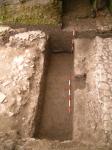Interpretation
-
- While wall 1752 might have supported the front balustrade of the vasca where the grapes were crushed, the thin (7-8 cm) lining on the other side of the cocciopesto might have supported the back balustrade. Only the area with cocciopesto would have been used for the crushing, while the area with standard concrete might have supported a trapetum. The semicircular cut above the vasca (1020) was probably the place of the drain into it.
-
- Marco Maiuro
- 23-7-2007
Stratigraphic Relationships
- No Linked Records
- No Linked Records
Description
- Calcatorium
- shape, construction, method
- good
- concrete
- reticulate
- not visible
- tufa cubilia
- Large rectangular structure covering a vault, on front side (S) abutted by wall 1752. The core is made of rubble blocks of medium size, and was covered by a layer of cocciopesto. The cocciopesto runs N for 111 cm, where the top of the vault shows another facing to the S; this facing is covered with a layer in concrete of 7-8 cm. The rest of the structure is covered by a concrete layer, no cocciopesto (another 208 cm). In several places both the cocciopesto and concrete were cut by later postholes. A semicircular cut in the cocciopesto is visible in the symmetrical middle of the vasca.
Basic Information
- Calcatorium
Record Details
-
- Lisa Fentress
-
- Marco Maiuro
- Simona Pirolli
- 6-7-2006
